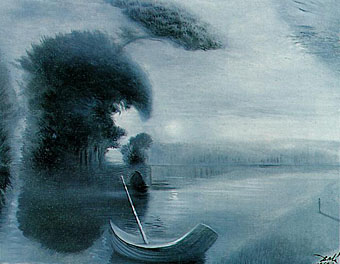
Metamorphosis of Hitler’s Face into a Moonlit Landscape with Accompaniment (1958).
Impressions de la Haute Mongolie (1976/Salvador Dali/José Montes-Baquer/Germany)
In any list of films I’d currently most like to see but can’t due to lack of availability, this bizarre “documentary” collaboration between Salvador Dalí and José Montes-Baquer would be near the top of the list. I saw it once, probably shortly after it had been made, when the BBC screened it as part of their Omnibus arts series in the late seventies. By this time I was already very familiar with the Surrealists, Dalí, Magritte and Max Ernst especially, so it was great to see Dalí himself declaring a supposed mission to explore Upper Mongolia in a search for giant hallucinogenic mushrooms. This premise aside, I remember few other details, the whole film was as delightfully confusing as might be expected. The most distinct memory was of the painting above being shown, then the camera pulling back some distance to reveal the full extent of Hitler’s face which is only hinted at in the original. Happily, a web review now provides us with some more details:
Homage to Impressions d’Afrique (1909), is a free-associative poem written by Raymond Roussel (1877-1933), even though he never visited Africa. The film is dedicated to this French author, forefather of the Surrealists, who developed a formal constraint system to generate inspiration from dislocative puns.
Dalí does the very same thing with this chimerical pseudocumentary leading us to the mysterious realm of High Mongolia where a gigantic white soft mushroom grows, many times more hallucinogenic than LSD! From his studio-museum in Cadacès (Spain), he proceeds to report on the alleged scientific expedition sent out by himself to retrieve this precious treasure, with newspaper clips and newsreel. Childhood memories (like the picture above) are the opportunity to explain more thoroughly the source of his inspiration. This bucolic landscape is in fact a close up of Hitler’s portrait (his nose and moustache) turned to the side!
Wholly Dalíesque, this film experiment pieces together astonishing combinations of superimposed images, fading in and out, switching scale with odd perspectives. Dalí invents a filmmaking process and applies his very language to cinematic purposes, bending the rules to serve his desperate need for originality. Travelling through a microscopic close up of paintings or rough surfaces, his voiceover commentary gives sense to the landscapes taking form under his eyes.
Impressions of Africa was also the title of a Dalí painting from 1938, of course:

It’s probably too much to hope that this will turn up on TV again, so for now I suppose I’ll have to look forward to it appearing on DVD at some point in the future. How about it José?
Update: Ubuweb has a copy!

Apart from the two Bunuel films, Hitchcock’s Spellbound and some Andy Warhol screentests Dali doesn’t seem to have left much of a filmography. Pity really. Shame nothing came of his Marx Bros screenplay. That would have been something to see.
http://www.imdb.com/name/nm0198557/
I still haven’t read the Roussel book. It might lose something in translation.
“Roussel’s most famous works are Impressions of Africa and Locus Solus, both written according to formal constraints based on homonymic puns. Roussel kept this compositional method a secret until the publication of his posthumous text, How I Wrote Certain of My Books, where he describes it as follows: “I chose two similar words. For example billiards and pilliards (looter). Then I added to it words similar but taken in two different directions, and I obtained two almost identical sentences thus. The two found sentences, it was a question of writing a tale which can start with the first and finish by the second. Amplifying the process then, I sought new words reporting itself to the word billiards, always to take them in a different direction than that which was presented first of all, and that provided me each time a creation moreover. The process evolved/moved and I was led to take an unspecified sentence, of which I drew from the images by dislocating it, a little as if it had been a question of extracting some from the drawings of rebus.” For example, Les lettres du blanc sur les bandes du vieux billard/The white letters on the cushions of the old billiard table? must somehow reach the phrase, ?les lettres du blanc sur les bandes du vieux pillard/letters [written by] a white man about the hordes of the old plunderer.”
but I have read that he slowly commited suicide by taking small amounts of posion knowing just when it would be fatal enough to finally kill him
“Perhaps not surprisingly, Roussel was unpopular during his lifetime and critical reception of his works was almost unanimously negative”
Still he did manage to make it into The A-Z of Great Writers by Tom Payne which is where I found out about him.
“He made his system known posthumously, sending the manuscript of How I wrote Some of My Books to be published after his death – which he timed by increasing his dosages of barbituates until they killed him. Even his end was part of a plan whose author never seemed eager tto let it be understood”
Dear Mr Coulthart,
If you are interested in an avi file of this film, please email me, soon … before “les graines disparaissent”
your blog is a rare pleasure!
—mahendra singh
Hi Mahendra. Thanks, but as noted above (and also here) the copy which Ubuweb acquired was sufficient to satisfy my curiosity. A very odd thing watching it again, I remembered some parts very well, others I’d completely forgotten about.
since I saw the film in january 1989 on a german tv-broedcasting, I tryed to find it – without succes One of the deepest experience of the creating power – and in the same time – the extreme antagonism of power- that art can be